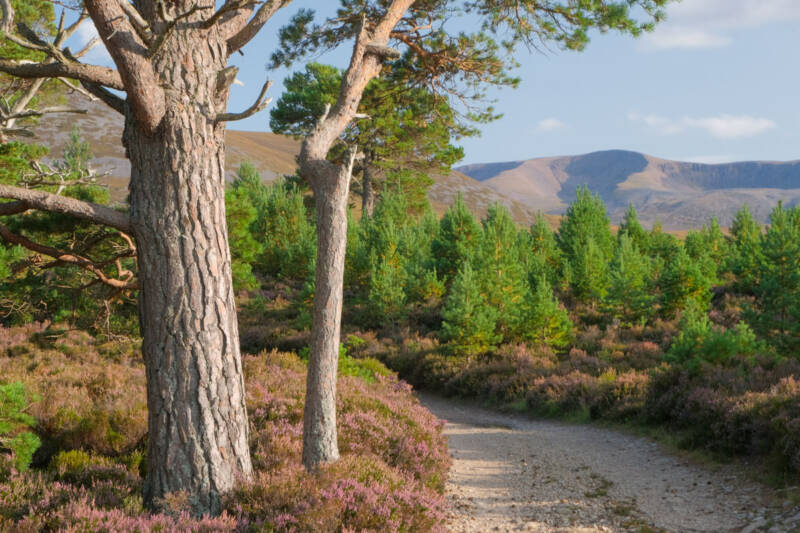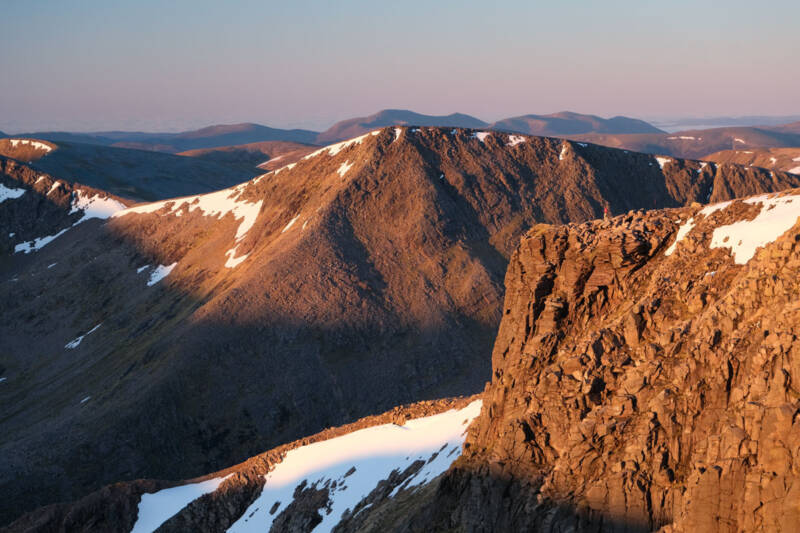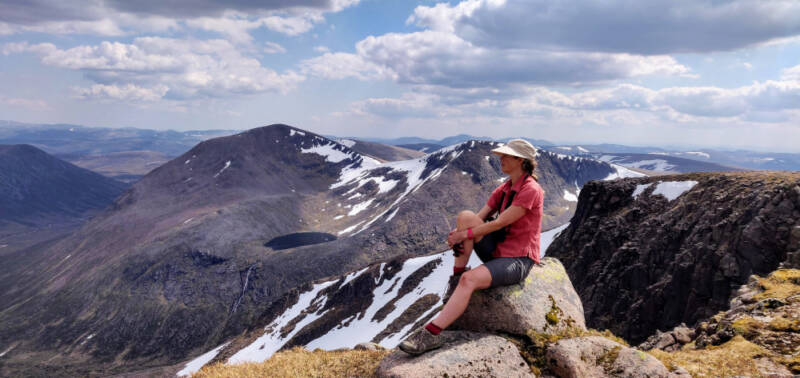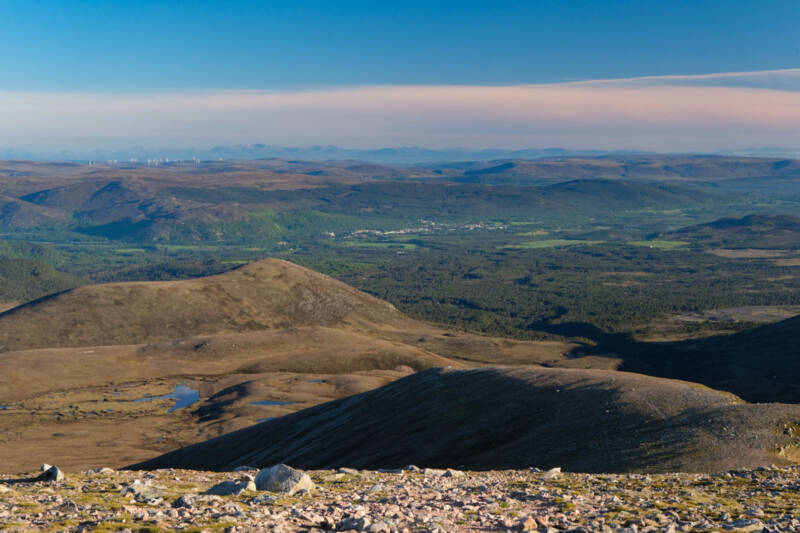
Badenoch writer and wanderer, Merryn Glover’s new book, The Hidden Fires: A Cairngorms Journey with Nan Shepherd, is an exploration of both The Living Mountain text and the iconic range that inspired it. In this extract, she recounts her first time on Braeriach – the mountain that can be equally divine or devilish – with Shepherd and other legendary Cairngorms authors as invisible guides.
The next time we could return to the plateau was 1 June and a day at the opposite end of the weather spectrum, one that Shepherd would call ‘delectable as honey’. This time we were on the western side of the Lairig Ghru, the ravine that cuts north–south through the range, and it was my first time climbing Braeriach. It’s a great beast of a hill, long and hulking with gaping corries gouged from its sides and rock- shattered precipices plunging from its rim. The name means ‘brindled upland’ in Gaelic and hints at the many faces, colours and moods of this inscrutable mountain. It can be dappled in greens and browns, or glowing red in the setting sun, or a haze of indigo. But also there are times when it is black with storm, or strafed by rain, and whole days when it descends into a weary grey or completely vanishes in cloud. Some of the most harrowing accounts of blizzard and blind stumbling in the Cairngorms come from Braeriach. In W.H. Murray’s transporting work Mountaineering in Scotland, he describes having to ‘crawl on hands and knees over the last twenty yards to the cairn, for we were unwilling to be picked up and hurled down the Lairig Ghru face’. So, on my first ascent of the great mountain, I could barely believe how benign she was, stretched out languidly in summer warmth, her flanks washed with light.

Of all the high tops of the Cairngorms, the plateau of Braeriach seems distinct. Shepherd spoke of its arctic qualities in the clarity of air and the tenacity and loveliness of its flowers. The naturalist Seton Gordon, who was the first to document the ecology of the Cairngorms in depth and whom Shepherd cites, likened it to the tundra of Spitsbergen, Norway. Of a July day in 1923, he wrote, ‘One saw the same gentle slopes, with lingering snowfields gleaming white, the same plants that crept prostrate or formed a dense stunted growth to shield them from the fierce winds that play here. There was the same exhilarating air, tense and vital.’ The day of our own summer expedition, the plateau unfurled around us, wide and rolling like a grassy sea, with not a breath of wind. I don’t think I’d ever felt such a stillness in the air so high in the Cairngorms, or such a capacity to stroll or sit or stretch out as the whim took, with no harassment from weather or midges. The faded blue sky domed above like a parachute, fleecy clouds caught in the seams, the sun at its peak. Behind us, the gulf of Glen Einich, from where we’d climbed, was steep and rimmed with rocky cliffs; before us, the walk to the summit was an easy rise.

When we got there, the views fell away on all sides in prodigal splendour. I could hear Shepherd, on her own midsummer day on Braeriach: ‘[T]here is nothing in all the sky but light. I can see to the ends of the earth and far up into the sky.’ The southern edge of the mountain makes a dizzying drop into Coire Brochain, the exact spot where she lay down on her stomach to listen to the plunge of waterfalls and watch deer feeding in the corrie floor. In the warmth and hushing sounds, she fell asleep, only to wake with shock at the sight of the chasm right in front of her. Coming to full consciousness, she realised it was not so far down, but that momentary vision, untethered from memory or logic, had provided a shot of pure and terrifying sensation. ‘I had looked into the abyss,’ she wrote. We stopped to gaze as well, but had miles to go before we could sleep. Further south lay the deep fold of a burn coursing down through the Garbh Choire, and beyond that, the twin summits of Cairn Toul and Sgòr an Lochain Uaine. A high lochan sparkled between them and the glinting was picked up by the long ribbon of the River Dee threading south down the Lairig Ghru to the hill of Càrn a’ Mhàim on the other bank. My eye curved all the way back up that ridge to the rounded bulk of Ben Macdui in the south-east, then Cairn Gorm just visible to the north-east, before dropping off the plateau to the lumpy moor. Directly north of us, the pyramid of Carn Eilrig blurred into the brown-green haze of the low hills and the forests of Glenmore and Rothiemurchus. Shepherd describes ‘a thick place’ at the hill’s foot where she lost her path: it had once been the location of an illicit whisky still making ‘a drop of the mountain dew’.

Further to the north-west, the forest gives way to the town of Aviemore. In her 1977 foreword, Shepherd wrote, ‘Aviemore erupts and goes on erupting.’ Back then, it was because of the skiing. What had been a quiet staging post grew to a village with the coming of the railways in the 1860s. Although pioneers had skied on the mountain since the late nineteenth century, the development really began in the 1950s, with local landowners and businesses seeing commercial opportunities, and climbing enthusiasts increasingly embracing skiing. Some had learnt it in Europe during Second World War service and nearly all proper mountain clothing and skis at the time were ex-army kit. When the ski road was built halfway up Cairn Gorm in 1960, and lifts and tows installed the following year, the eruption of Aviemore began. It also marked the early rumblings of conflict over exploitation versus protection of the mountain. This grew to another kind of eruption during the 1980s battle for Lurchers Gully over plans to significantly extend the ski infrasucture. Shepherd died in 1981, so did not witness that drawn-out and sometimes ugly dispute, but along with her blessing of those who ski, I think she would have been glad that the development was contained. Meanwhile, the volcanos grumble on. Aviemore continues to spill across the landscape and differing aspirations for the mountain and its surrounds persist. Less reliable snow and cheap flights to Europe have made the ski industry precarious, but other adventure sports flourish, from mountain biking to watersports to walking, all bringing ‘uplift for . . . many hearts’ but countless prints across the land.

Between Aviemore and where we stood on the summit of Braeriach, lies the hump of Creag Dhubh, Shepherd’s preliminary walk to the hem of the Cairngorms. It is the beginning of a ridge rising along the western side of Glen Einich and extending upwards to Sgòran Dubh Beag, Sgòran Dubh Mòr and the glorious, craggy outcrop of Sgòr Gaoith – Peak of the Wind. Finally, looking back to the south-west, the plateau flows down towards Moine Mhor, the Great Moss, a wide, rumpled blanket of grass and bog. I don’t think there is anywhere in the Cairngorms that offers a vision of all the range’s forms and features, with the valleys and forests that spread around it, so well as this spot. Jim Crumley, whose poem ‘Love is a Mountain’ was in our wedding service, describes the Braeriach plateau as a place of miracles, ‘as near to heaven on earth as makes no difference’. It’s like lines from Shepherd’s poem, ‘The Hill’:
So hard it was that morn to tell
If earth or heaven I saw
The Hidden Fires: A Cairngorms Journey with Nan Shepherd by Merryn Glover is published by Birlinn, hardback, £14.99
